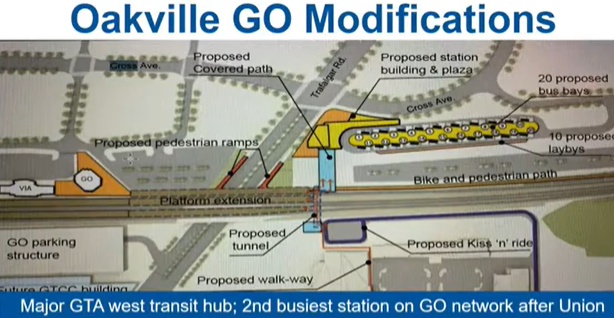Curb lanes on Dundas Street and Trafalgar Road should immediately be devoted to high occupancy vehicles (HOV), at least during peak hours.
That was one of several suggestions that Oakville Transit director Barry Cole made to the town’s planning and development council on Dec. 7, on his way out the door to retirement.
Reserving the lanes for HOV traffic is the necessary next step to planning for eventual bus rapid transit (BRT) service along those key corridors, said Cole.
“I want people in cars to see buses passing them in traffic,” he said.
Despite pressure from the town, Cole said Halton Region has resisted the push for the HOV lanes. But he warned that the potentially unpopular move will only get more difficult.
“You can expect some pushback, but nothing like the reaction if you try to take these lanes back five years from now,” he said.
“You need to start now. The ideal time was when they had the curb lanes (on Trafalgar) closed off and the widening was completed. When they opened them up, they should have opened as HOV.”
Cole also called for the eventual creation of a Halton-wide transit service, to improve service to riders and cover the costs of expansion and integration.
“I think that full regionalization of transit in Halton is the better way to go and I think that it’s probably the only way that each of the municipalities in Halton and the region itself will be able to meet their transportation goals,” he said.
“The cost is just too much, I believe, for a single lower-tier municipality to bear.”
He added that enhancing a range of transit services is crucial to support the future growth of Oakville and give people real transportation alternatives.
A full transit bus takes 40 vehicles off the road during rush hour, saving 70,000 litres of fuel and reducing air pollutants by nine tonnes a year, he said.
After thanking Cole for his 15 years of work, vision and caring town councillors endorsed the seven top priorities outlined in his report.
The seven priority projects are:
Transit Fleet Electrification
Oakville Transit diesel buses currently travel almost six million kilometres a year, noted Cole. “That’s a lot of greenhouse gas emissions and electrification eliminates all of it.”
A planned transition to a full fleet of battery electric buses is underway, thanks to $66.3 m project that has attracted nearly $50 million in funding from the provincial and federal governments.
Electrification will also lower maintenance, operating and whole life costs while improving rider experience and eliminating noise, said Cole.
Bus Rapid Transit (BRT) on Trafalgar and Dundas
The idea behind BRT is to provide a dedicated lane for buses, allowing for faster, more reliable and more frequent transit service.
The Trafalgar corridor would run from the GO station to the 407 parking area, while the long-term vision is for a Dundas Street BRT running from Toronto’s Kipling station to Hamilton.
Plans for BRT along these two corridors appear in a range of Metrolinx, regional and town plans.
Town staff will continue to press the region to install HOV lanes on the curb lanes of each of these corridors, according to a press release issued after the council meeting.
Palermo Transit terminal
A major transit hub is planned for Bronte Road and Dundas Street, to accommodate significant planned growth in the Palermo area. The terminal will connect future North Oakville bus routes and the growth area surrounding the Bronte GO station.
The town has budgeted $21.45 million to purchase land in 2022, along with an additional $5.6 million for construction in 2028/29.
Midtown including Oakville GO modifications
The Midtown area around the Oakville GO station is planned for the densest and most substantial growth in the Oakville area, with transit an essential part of moving people around the area.
Big changes will be needed to make that work, warned Cole, including a new bridge over the QEW to provide direct Trafalgar BRT access into the GO station.
In the short term, the GO station needs improvements to provide priority egress for buses, better safety features for pedestrians and charging infrastructure for electric vehicles.
“Longer term, the station needs to be relocated and it needs to be done in conjunction with the Midtown development,” said Cole, showing a map of proposed possible changes.

Connectivity with 15-minute GO train service
With work underway to expand the Lakeshore West GO line and bring two-way, all-day service to Oakville, the town’s bus service needs more frequent buses and better connectivity, Cole said.
“15-minute GO train service is of little use to local users who get off the train and wait for a 60-minute bus,” he said.
Enhanced and expanded on-demand services
Great transit may not always be about getting buses to people; sometimes it’s about getting people to buses.
Ride-hailing apps and other technologies, combined with an on-demand service that connects people with fixed transit routes can be an economical and effective way to improve customer service, Cole told councillors.
The aim is to provide a convenient and responsive system using a range of vehicles to meet the needs in different areas and at different times of day.
“We don’t need a bus if a van will do, and we don’t need a van if a sedan will suffice,” explained Cole.
While Oakville Transit already operates on-demand Home to Hub and care-A-van services, expanded and enhanced offerings should make the service available in more areas and to more residents.